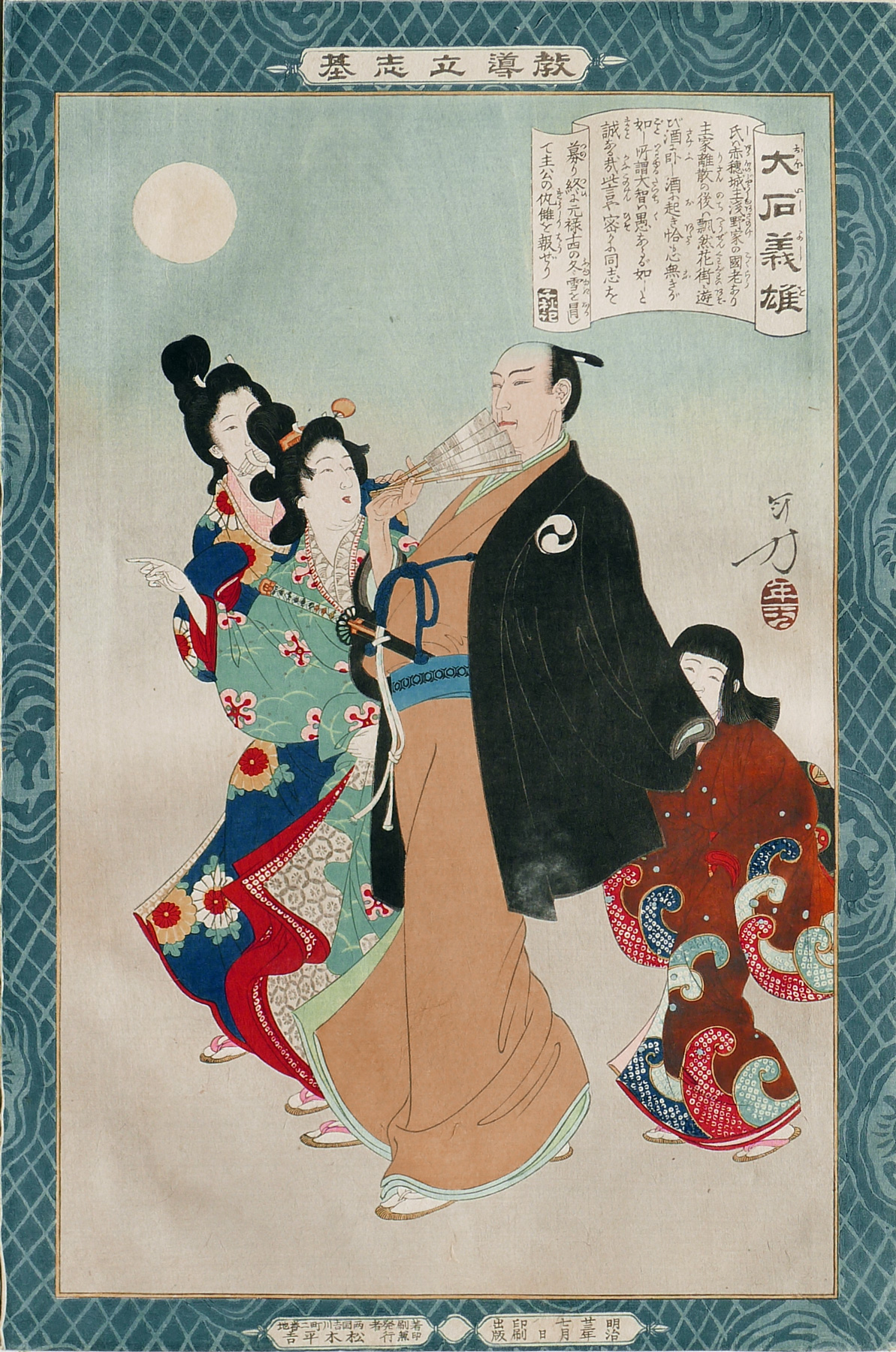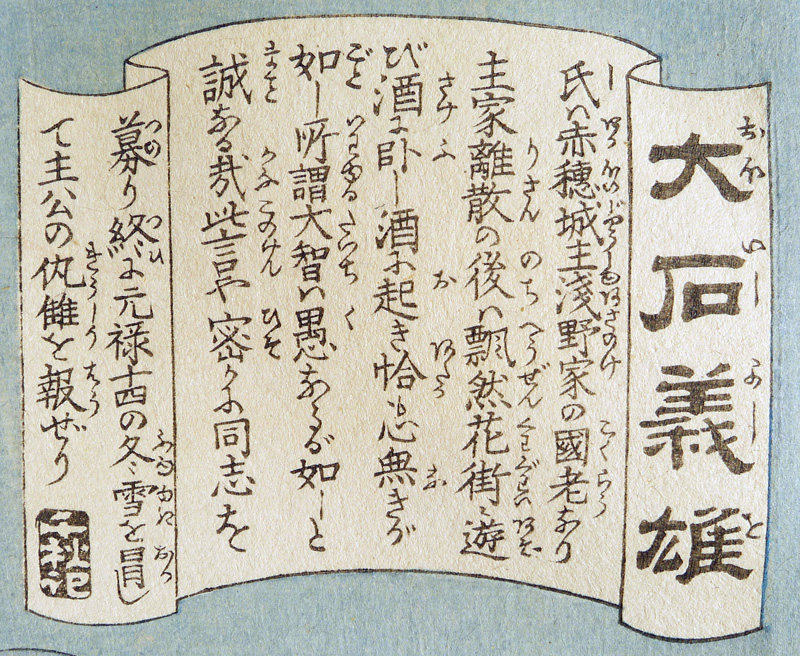About This Print
This unnumbered print1 in the series Instructive Models of Lofty Ambition pictures Ōishi Kuranosuke Yoshio (1659-1703) leader of the 47 Ronin surrounded by female entertainers under a full moon. This scene references Ōishi's ruse of living the high life with the geisha of Kyoto, while he was plotting his revenge on Lord Kira, who was responsible for his master Lord Asano's death. Ōishi's actions in avenging his master and his subsequent suicide, as ordered by the shogunate, was seen as ideal samurai behavior.1 Numbering of the prints was haphazard during the production of the series. While this print is unnumbered, the title for this print is shown in the 40th position listed in the Table of Contents for this series (reference Table of Contents from the series Instructive Models of Lofty Ambition). Print numbers were sometimes inadvertently omitted; some prints in the series were never assigned numbers and a few of the same numbers appear on different prints.
The Story of Ōishi Yoshio and the Forty-seven Ronin
Source: Traveller’s History of Japan, Richard Tames, Interlink Books, 4th edition 2008 , p. 105-107.
In 1701 Asano Naganori, lord of the Ako domain in the thenHarima province (now part of Hyogo prefecture) was ordered to serve as one ofthe shogun’s representatives to meet envoys bringing New Year greetings fromthe emperor to Kyoto. To prepare himselfappropriately he was obliged to receive instruction in the correct etiquettefrom the shogun’s chef d protocol,the greedy and conceited Kira Yoshinaka. Unfortunately Asano (or in some versions his steward) omitted todemonstrate his gratitude in advance by offering Kira s substantialfee/gift/bribe. Kira then behaved soarrogantly towards Asano that the latter, outraged, drew his sword and slashedat his tormentor. The swift interventionof another courtier deflected the blow and Kira escaped with a slightwound. But Asano had already signed hisown death-warrant by daring to draw a weapon within the precincts of the shogun’sresidence. Asano was condemned to commitseppuku, his estate was confiscatedand his entourage of samurai dismissed and cast adrift as ronin (literally ‘wave men’, i.e. having no direction,masterless). Kira went unpunished.
Asano’s chief retainer, Oishi Yoshio, dutifully supervisedthe hand-over of the estate, hoping that the house might be re-establishedunder Asano’s younger brother. When itbecame clear that this was not going to happen he plotted vengeance and unitedforty-six other loyal samurai in a secret blood-oath to pursue thevendetta. Realizing that Kira would takeextraordinary precautions against a possible revenge attack the conspiratorslay low and waited to throw off suspicion. Oishi himself set an extreme example by hiving himself over todrunkenness and debauchery, enduring the insults of other samurai for hisapparent gutlessness.
After two years the roninjudged that Kira believed himself to be safe from retribution and decided tostrike. Disguised as a detachment offiremen (so that they could carry ladders without arousing suspicion) theconspirators passed through deserted, snowy streets on the night of 14/15 December1702 and stormed Kira’s mansion. Dragging him from his hiding-place they beheaded him, took the head tothe grave of their master at Sengakuji temple and calmly awaited their fate.
The authorities were faced with a dilemma. The conspirators had showed to the highestdegree qualities most admirable in a warrior – loyalty, daring and, not least,dogged determination. Many admired them,from the common people to the shogun himself, and the head of the Hosokawaclan, into whose custody they were placed, treated them as honoured guests and offeredto take them on as vassals. On the otherhand their action was a clear defiance of the judgment passed upon their lordand, in the view of the shogun’s senior counselors, must be punished.
It was more than a month before a decision was reached. The shogun even took the unusual step ofappealing to the abbot of Ueno for his advice but he came down on the side ofthe death sentence on the grounds that the roninhad achieved a peak of spotless honour and, should they live on, some at leastwould be bound to tarnish their glory by a lapse of one sort or another. In the end there was a sort of compromise:rather than being executed as common criminals the offenders would be permittedto die like heroes by their own hand. They did so on 4 February 1703. (Only Chikara, Oishi’s son and the youngest of the conspirators, wasspared.) They now lie beside theirmaster at Senkaguji in Tokyo’s Minato district.
Transcription of Scroll
Source: with thanks to Yajifun http://yajifun.tumblr.com/“大石義雄(良雄) 氏ハ赤穂城主浅野家の國老なり主家離散の後ハ飄然花街ニ遊び酒に臥し酒に起き恰も心無きが如し 所謂大智ハ愚なるが如しと 誠なる哉此言や 密かに同志を募り終に元禄十四の冬雪を冒して主公の仇?(仇讐)を報ぜり 千秋 記”
About The Series "Kyōdō risshi no motoi"
Notes:1. This series is variously translated as "Instructive Models of Lofty Ambition," "Foundations of Learning and Achievement," "Foundation of Instruction and Perseverance," "Self-Made Men Worthy of Emulation," "Paragons of Instruction and Success," "Moral of Success," "Examples of Self-Made Leaders," and "Instruction in the Fundamentals of Success." The title in Japanese is sometimes seen as "Kyōdō risshiki or "Kyōdō risshi no moto," in addition to the most commonly seen transliteration of "Kyōdō risshi no motoi".2. For a complete listing of all the prints in the series and additional information please see the article on this site titled Instructive Models of Lofty Ambition.
This series ran between October 1885 and November 1890 and featured a long list of heroes and heroines, from antiquity to contemporary times, who were regarded as standards of moral leadership and self-realization.
Source: Kiyochika Artist of Meiji Japan, Henry D. Smith II, Santa Barbara Museum of Art, 1988, p. 74-75; original research and as footnoted.
This series of 58 prints,1 plus a table of contents sheet (目録), were originally published between October 1885 and November 1890 by the Tokyo publisher Matsuki Heikichi 松木平吉.2 The table of contents sheet issued by the publisher states that "fifty prints make up the complete set (五十番揃)". Three prints not in the initial release were added over the five year publication period, as were five redesigns of original prints, eventually increasing the total print count to 58. The seven artists contributing prints were Kobayashi Kiyochika (1847-1915) [20 prints], Mizuno Toshikata (1866-1908) [16 prints], Inoue Tankei (Yasuji) (1864-1889) [13 prints], Taiso (Tsukioka) Yoshitoshi (1839-1892) [5 prints], Yōshū Chikanobu (1838-1912) [2 prints], Toyohara Kunichika (1835–1900) [1 print], and Hachisuka (Utagawa) Kuniaki II (1835-1888) [1 print]. All the artists, with the exception of Yōshū Chikanobu, are listed in the top scroll of the table of contents sheet. Various colors (including blue, blue/green, and tan/brown) were used for the decorative border, and in 1902 the series was re-issued by Matsuki without borders.
Brief texts contained within a scroll-like cartouche appearing on each print provide historical details. The scroll composer's name is given at the end of the scroll text. The “lofty ambition” of the title is a Confucian concept, originally from Mencius, meaning “righteous determination that would inspire others.” The market for the series probably included former samurai, ambitious youth, and conservative intellectuals.
"[W]hen it was completed in 1890 the publisher was singled out for special recognition by the government for having sponsored such noble subject matter."3
This series ran between October 1885 and November 1890 and featured a long list of heroes and heroines, from antiquity to contemporary times, who were regarded as standards of moral leadership and self-realization.
This series of 58 prints,1 plus a table of contents sheet (目録), were originally published between October 1885 and November 1890 by the Tokyo publisher Matsuki Heikichi 松木平吉.2 The table of contents sheet issued by the publisher states that "fifty prints make up the complete set (五十番揃)". Three prints not in the initial release were added over the five year publication period, as were five redesigns of original prints, eventually increasing the total print count to 58. The seven artists contributing prints were Kobayashi Kiyochika (1847-1915) [20 prints], Mizuno Toshikata (1866-1908) [16 prints], Inoue Tankei (Yasuji) (1864-1889) [13 prints], Taiso (Tsukioka) Yoshitoshi (1839-1892) [5 prints], Yōshū Chikanobu (1838-1912) [2 prints], Toyohara Kunichika (1835–1900) [1 print], and Hachisuka (Utagawa) Kuniaki II (1835-1888) [1 print]. All the artists, with the exception of Yōshū Chikanobu, are listed in the top scroll of the table of contents sheet. Various colors (including blue, blue/green, and tan/brown) were used for the decorative border, and in 1902 the series was re-issued by Matsuki without borders.
Brief texts contained within a scroll-like cartouche appearing on each print provide historical details. The scroll composer's name is given at the end of the scroll text. The “lofty ambition” of the title is a Confucian concept, originally from Mencius, meaning “righteous determination that would inspire others.” The market for the series probably included former samurai, ambitious youth, and conservative intellectuals.
"[W]hen it was completed in 1890 the publisher was singled out for special recognition by the government for having sponsored such noble subject matter."3
1 The Tokyo Metropolitan Library online collection shows 50 prints and a Table of Contents sheet. The Table of Contents lists the titles of 50 prints. Smith in Kiyochika Artist of Meiji Japan identified 52 prints. I have identified 58 prints from this series including five prints (Ikina, Michizane Sugiwara, Kesa Gozen, Soga Brothers and Hokiichi Hanawa) that were re-designed and re-printed, likely due to damaged or lost blocks.
2 Robert Schaap notes in Appendix II, p. 166 of Yoshitoshi, Masterpieces from the Ed Freis Collection, Chris Uhlenbeck and Amy Reigle Newland, Hotei Publishing, 2011 that the series originally appeared as newspaper supplements.
3 The World of the Meiji Print: Impressions of a New Civilization, Julia Meech-Pekarik, Weatherhill, 1986, p. 122.
1 The Tokyo Metropolitan Library online collection shows 50 prints and a Table of Contents sheet. The Table of Contents lists the titles of 50 prints. Smith in Kiyochika Artist of Meiji Japan identified 52 prints. I have identified 58 prints from this series including five prints (Ikina, Michizane Sugiwara, Kesa Gozen, Soga Brothers and Hokiichi Hanawa) that were re-designed and re-printed, likely due to damaged or lost blocks.
2 Robert Schaap notes in Appendix II, p. 166 of Yoshitoshi, Masterpieces from the Ed Freis Collection, Chris Uhlenbeck and Amy Reigle Newland, Hotei Publishing, 2011 that the series originally appeared as newspaper supplements.
3 The World of the Meiji Print: Impressions of a New Civilization, Julia Meech-Pekarik, Weatherhill, 1986, p. 122.
Print Details
| IHL Catalog | #951 |
| Title or Description | Ōishi Yoshio 大石良雄 |
| Series | “Instructive Models of Lofty Ambition” (Kyodo risshiki 教導立志基) [note: seriestitle also listed as 'Kyodo Risshi no Moto', ‘Kyodo risshi no motoi’,‘Kyōdō risshi ki’ and variously translated as “Moral of success” or“Foundations of learning and achievement” or “Self-made Men Worthy ofEmulation”' or “Examples of Self-made Leaders” or "Paragons of instruction and success"] |
| Artist | Mizuno Toshikata (1866-1908) |
| Signature |  |
| Seal | Toshikata 年方 seal as shown above |
| Publication Date | July 1890 明治廿三年七月 日 |
| Publisher | Matsuki Heikichi (松木平吉) proprietor of Daikokuya Heikichi [Marks: seal not shown; pub. ref. 029] click on image to enlarge (from right to left) publishing and printing date: 明治廿三年七月 日 印刷 出版 [Meiji 23 7th month, printing and publication] assigned number within series: number omitted publisher information: 著印刷兼発行者 両国吉川町二番地 松木平吉 [printer and publisher Ryōgoku Yoshikawachō 2-banchi Matsuki Heikichi] |
| Impression | excellent |
| Colors | excellent |
| Condition | good - backed; trimmed to image; minor soiling; minor waviness to paper |
| Genre | ukiyo-e; rishki-e; kyōiku nishiki-e |
| Miscellaneous | no editions of this print that I have seen carry a print number; position 40 in the Table of Contents for the series |
| Format | vertical oban |
| H x W Paper | 14 1/16 x 9 1/4 in. (35.7 x 23.5 cm) |
| H x W Image | 14 x 9 1/4 in. (35.6 x 23.5 cm) [12 1/2 x 8 in. (31.8 x 20.6 cm) area inside brocade border] |
| Literature | |
| Collections This Print | Tokyo Metropolitan Library 258-C030 |



